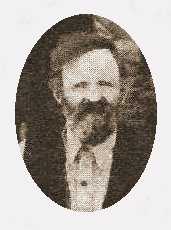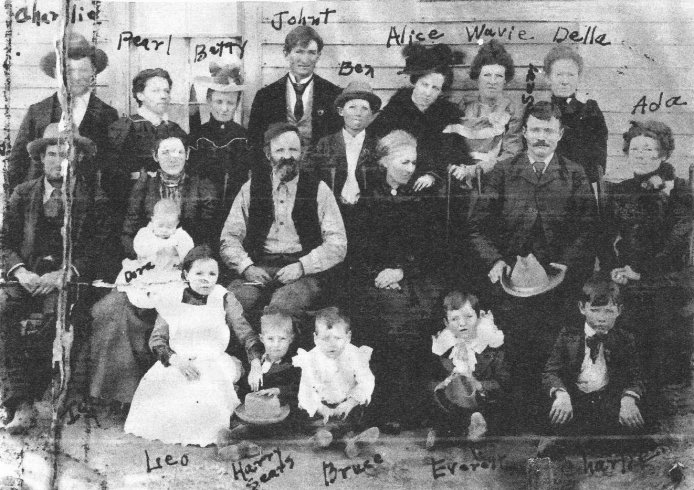
Barber County Kansas

 |
Barber County Kansas |
 |

Greenville Adams, circa 1900.
Photo from the collection of Kim Fowles.
Green Adams was born in McGoflen county, Kentucky, No. 15, 1851 and died at his home in Sun City Sunday, October 26, 1930, aged 75 years, eleven months and eleven days.He was married to Roseana Helton, April 20, 1871 and to this union were born eleven children, one of whom preceded him in death.
In 1872 Mr. Adams came to Barber county, and settled near Sun City, where he lived until his death at the time of which he was the earliest residents of the county.
His wife died Jan. 12, 1903 and later he was married to Myrtle Shumacker of Sun City on April 4, 1928. Mr. Adams professed faith in Christ and was baptized into the fellowship of the Baptist church, and later took an active part in the erection of the Sun City Baptist church, being one of its charter members.
The children who mourn his death include Charley Adams, Clayton, N. M.; Morgan Adams, Chicago, Ill.; Bettie of Medicine Lodge; Jonathan of Arthur, Neb.; Alice of Tracy, Calif.; Waive of Gibbons, Okla.; Ada of Arthur, Neb.; Ben and Leo of Medicine Lodge and Bruce of Sun City. In addition to these, he leaves a sister, Mollie Sanders of Sun City; two half-sisters, Atlanta Peterson of Lamont, Okla., and Eliza Fulton, of Freedom, Okla., a half-brother, McClelland Adams of Hardtner, Kan., one step-son, Claire Shumaker, Eldorado, Kan.; 27 grandchildren, 11 great grandchildren and a a host of other relatives and friends.
Funeral services were held at the Sun City Baptist church Wednesday, Oct. 29, with Rev. Ford in charge, after which interment was made in the Lake City Cemetery.

The Family of Green and Roseanna Helton Adams, circa 1900.
Back: Charlie Adams, Pearl Frame Adams, Betty Adams Scott, Johnathan Adams, Ben Adams, Alice Adams Ward, Wavie Adams Lacy, Della Adams Shultz. Middle: Morgan Adams, Ivy Bell Adams with child Dora Adams, Green Adams (son of Rev. J.M. 'Bud" Adams), wife Roseanna Helton (dau. of A.J. & Delphia Wireman Helton), Sam Shultz, Ada Adams Ward. Front: Leo Adams (later m. Jack Ryckman), Harry Sears (son of Betty), Bruce Adams, Everett Shultz and Charlie Shultz (sons of Della). Photo from the collection of Kim Fowles.
Johnson M. Adams, father of Green Adams.
Lee Adams, son of Johnson Adams, killed in an argument over gambling in a "whiskey shop" in Sun City which was owned by Greenville Adams, another son of J.M. Adams.
Oscar Lindgren & Atlanta (Adams) Peterson, Atlanta Adams was the half-sister of Greenville Adams.
Della (Adams) Shultz, daughter of Green Adams.
Green Adams Describe Things As He Saw Them In Barber County In The Early 1870's
Barber County Index, October 6, 1927.Green Adams: An Early Day Vigilante Committee
Barber County Index, October 13, 1927.Photo: Roundup in Barber County, 1894., courtesy of Mary Lou (Elsea) Hinz. (Green Adams in included in this photograph.)
Bruce Adams, son of Green Adams.
Lee Wynkoop: "Recalls Narrow Escape From Indians"
(Undated newspaper clippings.)Township 31 South, Range XV West of the 6th P.M.
Map of the area southwest of Sun City, Kansas.
From Standard Atlas of Barber County, Kansas, 1905.

At left: Greenville Adams, circa 1900.
Photo courtesy of Kim Fowles.Green Adams is one of the real "old timers" of Barber County. His experiences in the western country could well be woven into a most interesting and thrilling book. In addition to hunting buffalo for a living for a number of years, and selling their hides at Wichita at that time a very small village, Mr. Adams took an active part in all the activities of this part of the country. He is probably the oldest living settler in Barber county, although he says that Mart Updegraff may have come a short time prior to his reaching Barber county. Mr. Adams has lived in or near Sun City all these years. He is known to all the "old timers" of the county and to a great many people who came during the later years. Mr. Adams was in Medicine Lodge last Saturday and was prevailed upon to tell something of how he happened to come to this part of the state. He said:
"I came from Kentucky in the fall of 1872 in a covered wagon. Wintered in Douglas county. This was the winter that Pomeroy was defeated for the U. S. senate by John J. Ingalls, which contest caused considerable excitement. The first of March 1973, (1873) I came to Barber county. A great many people wonder why I came to Barber county when I passed over so much good land further east. The reason was because there was plenty of timber and water in Barber county. As I came from a heavily timbered country I didn't think I could get along without timber. We came from Wichita over what was known as the Griffin Trail. At the head of Elm Creek we camped all night and our teams went on for Sun City and six or eight of us came down Elm Creek. Wild turkey were very numerous. We killed a large turkey and cooked and ate him right south of the Lodge. That was April 2, 1873. There was not but one house in course of erection, and that was known as the Updegraff hotel, made of cottonwood logs. We went the next day, April 3, 1873, to Sun City, and no buildings were in sight at that time. But Griffin had about six dug-outs and we used one of them.
"The Indians were very numerous and when there were some buildings in Sun City it became a trading post for the Indians. The men had quite a time to convince the women that there was no danger of the Indians, but there was a man by the name of Kune, who had a little boy about 14 years old, out herding cattle when the Indians came across him and killed him and scalped him. He was brought to Sun City to be buried and we had quite a stampede with the women, who refused to be pacified.
The Indians in 1874 went on the war-path. That was the time Sitting Bull led the Cheyennes, when they killed a great many people on the trail. I never knew of but one Indian who was killed, who was killed by a man by the name of Gorman on Bluff Creek. Two Indians came to his ranch and started away with about 75 head of saddle horses. There were about six cowboys at Gorman's ranch at that time. Gorman told the boys to get their guns that he wasn't going to see these red-skins drive off his horses. The boys told Mr. Gorman that they hadn't lost any Indians.(horses) He had a good saddle horse and he buckled a couple of six shooters on him and went after the Indians, one of whom was riding a lame horse. Overtaking him quickly, he shot this Indian off his horse and went after the other one, who was coming to a bluff forced his horse down it, When Gorman go to the bluff he looked over and saw the whole tribe camped. Naturally he didn't care to follow him any further. He rode back past the Indian he had shot, who was sitting up sticking leaves in the bullet hole to stop the flow of blood. Gorman gave him another shot, got off his horse and scalped him and went to his ranch and showed the boys what he had done. To my certain knowledge, that was the only Indian who was killed.
"The Indians camped south of Dodge City in what was known as the Red Hills. There were 60 of the cowboys and a company of soldiers. The cowboys were anxious to rout the Indians out, claiming to the soldiers that this was the only water hole in some distance, but the captain was a little too smart to be caught in a trap. I talked to a man by the name of Collins who was with the boys at the time, who said that to satisfy the boys he was going in with them, but there never would have been a man come out alive, as they had only one way to get into them, and as the Indians had sixteen rifle pits the white men would have had been mowed down like flies. The report came in that the Indians had killed a man down at Colcord's camp, and with about sixteen other men I went down there to bury him. When we got to the dugout we saw where he had been killed by the blood spots, but could not find him for quite a while. They had dragged him for about 75 yards and thrown him in a little brook. We dug a grave and wrapped him in two blankets and buried him. His name was Dow. I marked the spot with a stone and am confident I could find his grave today.
The Barber County Index, October 13, 1927. An Early Day Vigilante Committee
How Barber County Vigilante Committee Worked in the Seventies

At left: Greenville Adams, circa 1900.
Photo courtesy of Kim Fowles.Green Adams, pioneer resident of Barber county recalls some of the trials and problems of the settlers in this county and has given the Index the following account of an incident in connection with the activity of a vigilante committee.
"When I landed in Barber county this country was filled up with horse thieves and desperadoes. I have seen all of the bad men of the west. Bill Brooks and Bill Anderson or "Hurricane Bill," who was the finest specimen of a man I ever saw. But Bill Brooks wore his hair long and looked like an awful bad man. It looked as though it was impossible for a man who wanted to live upright to stay here, because they are stealing all the good horses that were in the country. The men had a meeting to adopt some plan to stop the stealing. So we formed what was called a vigilante committee, to which about 75 men belonged. We had meetings about three times a week.
"A man by the name of Walker had a team stolen. Suspicion pointed to a man by the name of Parker. A meeting was called and a decision made to make an example of someone. And fate decreed that Parker was the man. He worked near the head of the river on a cattle ranch coming to town every Sunday. I was one of the chosen to arrest Parker. Two other men, Puckett and Montgomery were with me. We went up the river and waited for Parker, but he went a different road. We were not discouraged but continued to wait. He passed us before we saw him. We started after him in full pursuit and ran him a mile before overtaking him. Mr. Montgomery dropped out during the chase and was not there when the arrest was made. Parker was taken over in the canyons south of the river but we hardly knew what to do as it was a big job for two men, to hang him. A council was held at which I agreed to stay and keep Parker while Puckett went to town after the rest of the committee. Parker suspected at once as to what was going to take place. Of all the crying and praying that I ever heard, he did it. I say very frankly that I shed a few tears myself. About eleven o'clock Puckett came back and reported that there wasn't a man who would come and help hang him. We realized that something had to be done, so we proceeded to do it. We started toward town with Parker in front of us. When we reached Turkey Creek I told Parker to hit the grit. He didn't seem to be very anxious to go because he was afraid I would shoot him. But I knew within my own mind that Parker was perfectly safe, but I told him when he left to go clear out of the country. I have never laid eyes on Parker since, and never was anxious to do so. I got home that morning about three o'clock, and told my wife that I never would attend another of their vigilante meetings. The very idea of men going to work to hang a man on suspicion, wasn't what it was cracked up to be. If any old timer happens to read this article, they will know what Parker it was for he is known as 'Bolivar.' "
Also see:
Memoirs of Phoebe (Rogers) Gibson:
The Early Days of Barber County, Kansas
Barber County Index, May 16, 1929.Lee Wynkoop: "Recalls Narrow Escape From Indians"
(Undated newspaper clippings.)
Thanks to Shirley Brier for finding, transcribing and contributing the above news article to this web site!